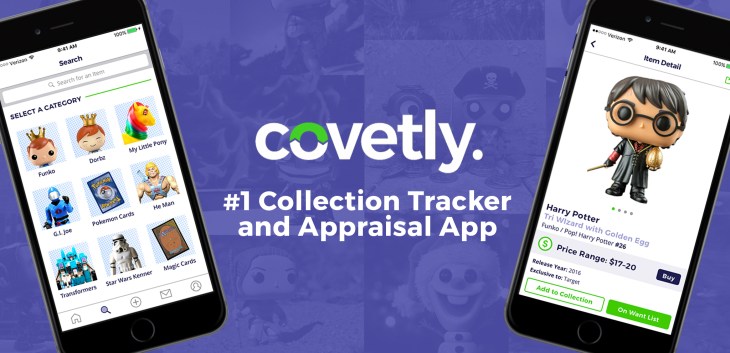Collecting is at the heart of most human endeavors… and it’s why the three founders of Covetly, one of the companies graduating from Y Combinator’s latest accelerator batch, launched their business — to make collecting even easier.
Each Covetly founder is a collector himself. For 39-year-old Reid Nahm, who previously worked for a lost and found recovery service, it was comic books (specifically Spider-Man); 28-year-old Brian Law was a Pokémon and Magic: The Gathering card aficionado; 37-year-old Evan Beland stocked up on “every toy category that’s vintage.”
“Brian and I had been working on this pretty much from the start,” says Nahm. “The first version of Covetly in 2015 was almost like a Tinder for stuff. Users told us they wanted an app to trade things… and great people were matching with each other, but they didn’t know how much their stuff was worth.”
To solve the problem, Covetly began offering pricing and curation services as a way to make the process of buying and selling even smoother on mobile devices.
 In the old days (when I was collecting comics), you’d have to look up pricing information in books like the “Overstreet Comic Books Price Guide.” Using Covetly, that information is at the fingertips of both buyers and sellers.
In the old days (when I was collecting comics), you’d have to look up pricing information in books like the “Overstreet Comic Books Price Guide.” Using Covetly, that information is at the fingertips of both buyers and sellers.
“Think of the old magazines, where you look up your stuff. From there it evolved into a collection management system,” says Nahm. “You really look at it like you would a stock portfolio.”
Unlike the web’s eBay, which is a bit more haphazard in its organization, the founders of Covetly wanted to organize their marketplace.
“We always knew marketplaces were the most likely destination,” says Beland. “We wanted to really help collectors throughout the entire collection process, not just a place where they go and drop in and buy stuff.”
Since the app’s operators are managing the marketplace using a mix of organizational tools, they have product descriptions down to an item’s Stock Keeping Unit number.
“If you look at the app, the greatest example is the My Little Pony section,” says Beland. “We have every single one that was ever made.”
Covetly is clearly more than just a business for the three collectors. “We all had gone down this journey as collectors ourselves,” says Nahm.
And despite the notion that youth culture today eschews things for experiences, Nahm, Law and Beland all say there’s a brisk business in the flotsam and jetsam of cultural curiosities.
Nahm points to Funko POP, the maker of bobblehead dolls that’s going to record $600 million in sales this year. And despite digitization, comic books remain a multi-billion-dollar publishing business, he said.
In 2017 alone collectors uploaded more than $20 million in items, from Funko, G.I. Joe, Master of the Universe and My Little Pony collectibles, to Pokémon, Star Wars Kenner and Transformers.

Covetly co-founders
“You can take a step back… it doesn’t matter what your income level is you have things around you that inspire you,” says Nahm. “If you’re a millionaire you have a Picasso or a Warhol that inspire you. People relate to the characters and the stories and relate to the hero’s journey… that’s one of the greatest things about what we’re doing … we’re building this platform that people use to research the things that inspire them.”
It’s true that people are natural collectors. Like the mythical magpie, we have collected objects to beautify and commemorate as long as we, as a species, have been able to beautify and commemorate.
Billions of dollars are spent on things that have no inherent value outside of their connection to a mystic chord of some memory. From bobbleheads and figurines to books and music, the urge to collect is something intrinsic in human experience, as it ties us to something in our past selves.
Nowhere is this better described than in a 1931 essay by the German literary critic Walter Benjamin:
… there is in the life of a collector a dialectical tension between the poles of disorder and order. Naturally, his existence is tied to many other things as well: to a very mysterious relationship to ownership, something about which we will have more to say later; also, to a relationship to objects which does not emphasize their functional, utilitarian value — that is, their usefulness — but studies and loves them as a the scene, the stage, of their fate. The most profound enchantment for the collector is the locking of individual items within the magic circle in which they are fixed as the final thrill, the thrill of acquisition, passes over them. everything remembered and thought, everything conscious, becomes the pedestal, the frame, the base, the lock of his property.
With all of this meaning assigned to what amounts to little more than the cultural detritus of any age, it’s no wonder that one of technology’s first big billion-dollar-businesses was eBay — a company founded to help buyers and sellers of any object connect online.
It’s also why the myth persisted that the company’s founder, Pierre Omidyar, built the business to help his wife build out her Pez dispenser collection. And it’s the driving force behind Covetly’s success.
